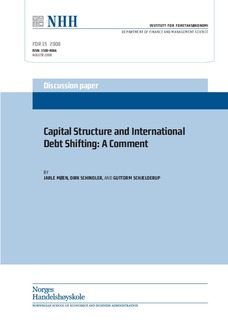| dc.contributor.author | Møen, Jarle | |
| dc.contributor.author | Schindler, Dirk | |
| dc.contributor.author | Schjelderup, Guttorm | |
| dc.date.accessioned | 2008-10-21T10:41:25Z | |
| dc.date.available | 2008-10-21T10:41:25Z | |
| dc.date.issued | 2008-08 | |
| dc.identifier.issn | 1500-4066 | |
| dc.identifier.uri | http://hdl.handle.net/11250/164127 | |
| dc.description.abstract | In a recent article, Huizinga, Laeven and Nicodème (2008) present
a novel model that motivates an extensive empirical analysis of international
debt shifting. We point out that the model fails to account
for internal debt, and that once internal debt is properly accounted
for, the external debt mechanism they propose is not identified in the
empirical analysis. We also point out that affiliate specific debt costs
reduce affiliate dividends. When this is implemented in the model,
their regression equation can only be derived under the very restrictive
assumption that effective tax rates on dividends are the same in
all countries. | en |
| dc.language.iso | eng | en |
| dc.publisher | Norwegian School of Economics and Business Administration. Department of Finance and Management Science | en |
| dc.relation.ispartofseries | Discussion paper | en |
| dc.relation.ispartofseries | 2008:15 | en |
| dc.title | Capital structure and international debt shifting: a comment | en |
| dc.type | Working paper | en |
| dc.subject.nsi | VDP::Samfunnsvitenskap: 200::Økonomi: 210::Samfunnsøkonomi: 212 | en |
